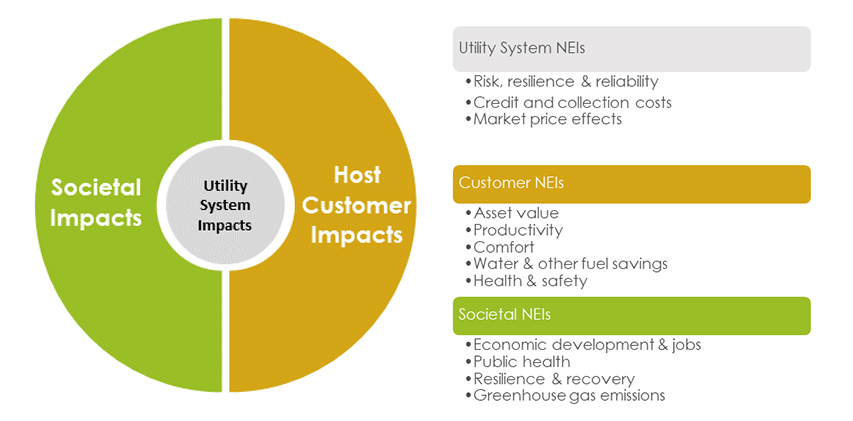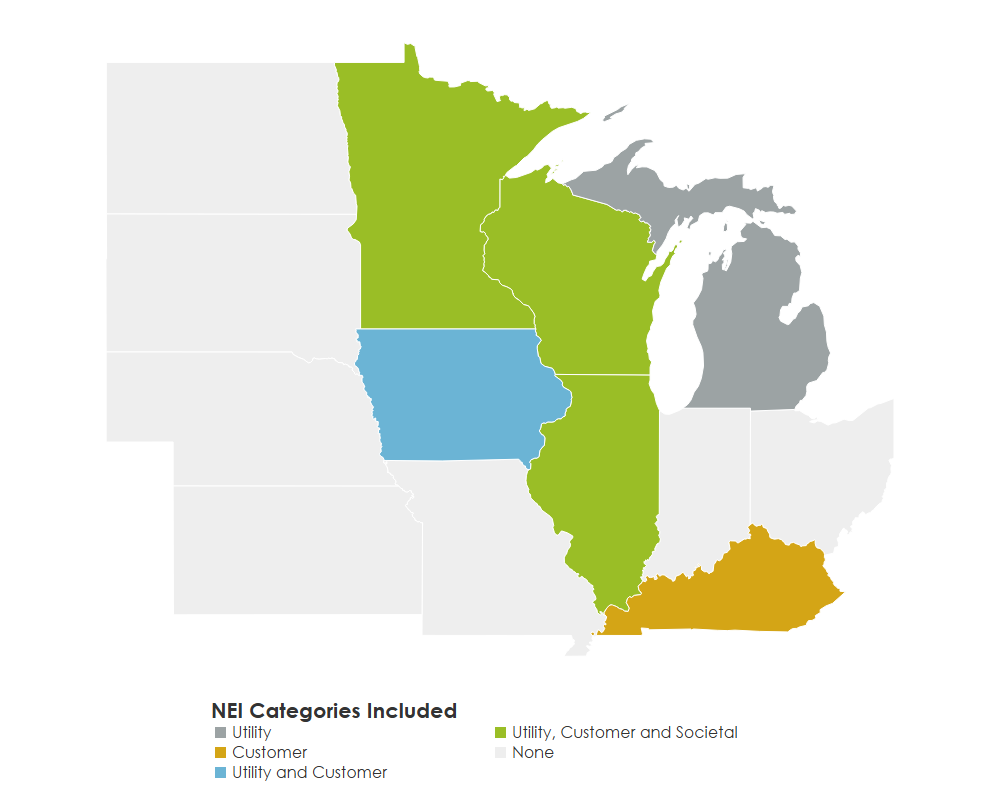Non-Energy Impacts of Energy Efficiency
Non-Energy Impacts (NEIs) are the benefits and costs of energy efficiency and other distributed energy resources (DERs) in addition to the energy and demand impacts. To account for the full value of EE and DERs in reaching policy goals, NEIs can and should be considered.
How are NEIs used?
- Regulators can use NEIs to assess progress towards meeting policy goals.
- Utilities and their evaluators can use NEIs in benefit-cost analysis (BCA).
- Implementers and energy service companies (ESCOs) can use NEIs to refine energy efficiency offerings and market them more effectively to customers.
- Customers can consider NEIs when deciding to make energy efficiency and other clean energy upgrades.
- Utilities can use NEIs to understand the value of energy efficiency and DERs as resources in long-term planning.
Examples of NEIs
Impacts of EE and DERs can accrue to the utility system, to the host customer (e.g., EE program participants) and to society at large. These impacts include both energy and non-energy impacts. Some examples of the NEIs for each part are shown to the right.
The National Standard Practice Manual (NSPM) is a framework for understanding the impacts of energy resources and how we use them to support policy goals. It contains detailed information on these and other impacts from energy efficiency and DERs.

NEIs and Equity
Low-income customers have the same types of NEIs as non-low-income customers, but the magnitude of these impacts can be much higher. This is because low-income customers have a higher economic burden relative to income and often live in much less efficient housing stock. The energy efficiency improvements are therefore closing a much wider gap than they would be for higher-income customers. Some NEIs such as the reduced risk of foreclosure or need to change residence due to unpaid bills are unique to this subset of customers.
Use of NEIs in Benefit Cost Analysis
Regulators and utilities seek to ensure that energy efficiency programs and portfolios are cost-effective – providing at least the same level of benefits as they have in costs. The benefit and cost categories that are included in the analysis come from the chosen cost-effectiveness test. The primary test for a jurisdiction is the main tool for screening out ineffective choices. A measure or program that passes the primary test with a benefit-cost ratio (BCR) of 1.0 or higher is worth considering as part of the portfolio in planning and is considered prudent in post-program reporting. Other tests may be considered as secondary tests for additional prioritization.
| Test | Can this test include NEIs? |
| Total Resource Cost Test (TRC) | Yes. Utility system and customer NEIs. |
| Societal Cost Test (SCT) | Yes. Utility system, customer and societal NEIs. |
| Utility Cost Test (UCT) | Yes. Utility system NEIs. |
| Jurisdiction-Specific Test (JST) | Yes. All NEIs that are relevant to meeting policy goals. |
Approaches to Incorporating NEIs in Benefit Cost Analysis
- Monetized: jurisdiction-specific studies, or those from other jurisdictions or national studies can provide informed estimates. Proxies or percent adders can be used for harder-to-monetize impacts.
- Alternative thresholds: for some impacts, a benefit cost ratio that is less than 1.0 can be a simple way to account for impacts that would not otherwise be included. This is often used for low-income programs that provide broad societal benefits but would not pass the standard primary test because of higher system costs.
- Qualitative: When impacts cannot be monetized, qualitative comparison between resource options can still be used to help prioritize choices.
Use of NEIs in Benefit Cost Analysis in the Midwest

Not every state in the Midwest uses NEIs in its benefit cost analysis. Those that do draw on some but not all of the possible NEIs from one or more of the broad categories of utility, host customer and societal NEIs. Those that are used depend on the perspective of the test and the state’s policies. Of the states in the Midwest, Minnesota has the broadest range of NEIs included in its jurisdiction-specific “Minnesota Test.”
In practice, states use different benefits and costs in their tests – even if those tests have the same name, they may be testing different impacts. State policies are the most important driver of which impacts are included, but experience with the use of NEIs and methodologies used to measure them are also a factor.
The Database of Screening Practices (DSP) provides detailed analysis of the energy and non-energy impacts used by every state.